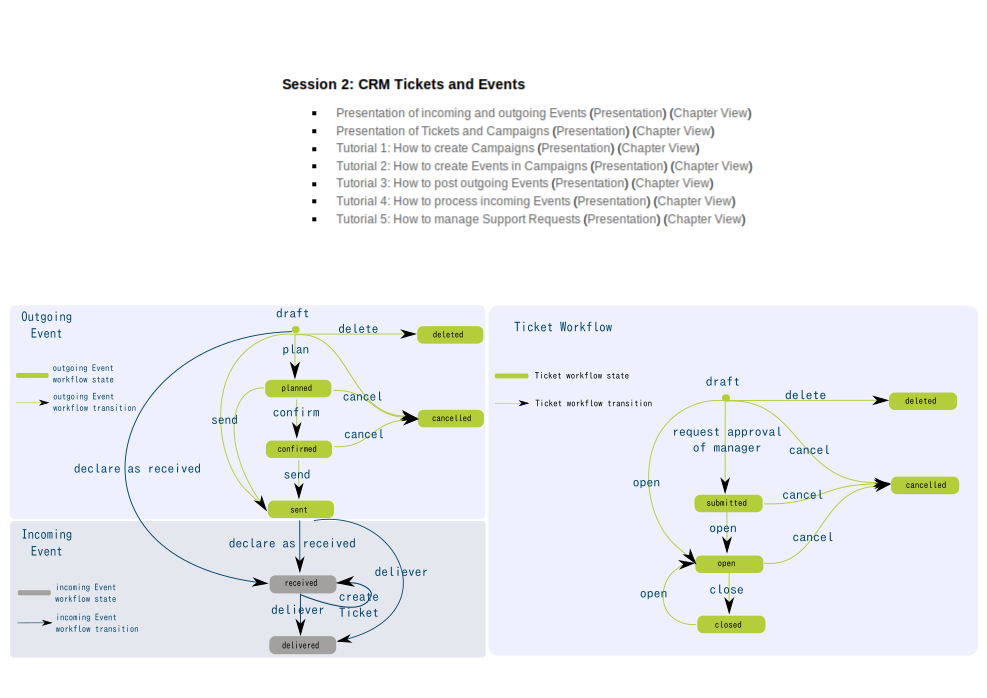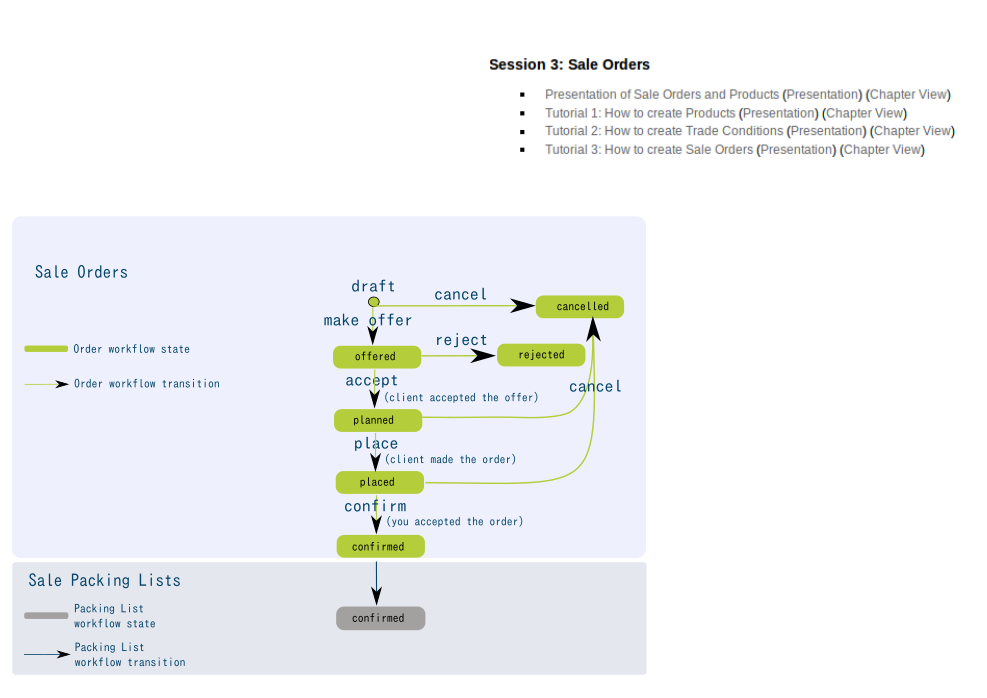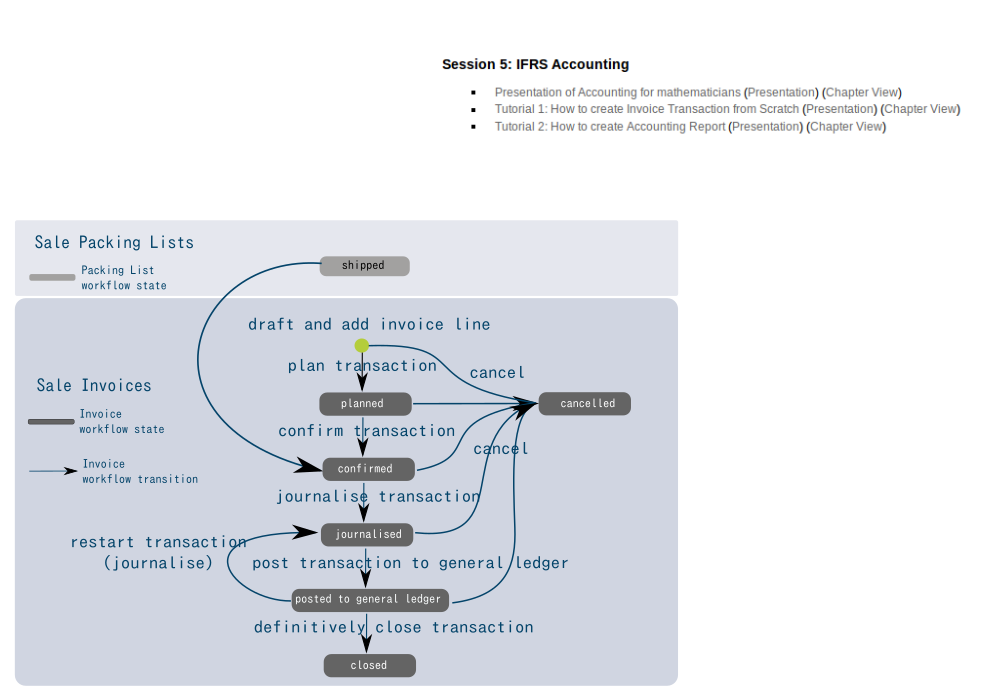Anderson de Melo Valadão, Klaus Wölfel, Jingjing XU, Mayoro Diagne, Sven Franck, Ni Yan |
ERP: Theory, Practice and Configuration - Introduction
ERP and Configuration Introduction

This visual guide is part of a collection of documents created by the One Student One ERP (OSOE) project in collaboration with Institut Mines Telecom, Telecom Bretagne, Dresden University of Technology and the South Westfalia University of Applied Sciences. It can be used to teach modern ERP theory and practice to undergraduate students or professionals.
This chapter introduces the lecture goal, organisation and evaluation.
Copyright: You are free to copy, distribute, display, and perform the work under the following conditions: you must attribute the work in the manner specified by the author or licensor; you may not use this work for any commercial purposes including training, consulting, advertising, self-advertising, publishing, etc.; you may not alter, transform, or build upon this work. For any reuse or distribution, you must make clear to others the license terms of this work. Any of these conditions can be waived if you get permission from the copyright holder through a commercial license or an educational license. For more information, contact info@nexedi.com
Agenda
- What are the objectives of the course
- How the sessions are organised
- How you will be evaluated
In this presentation, we are going to explain how this lecture was designed. First, we define the goals of the course and especially what students can expect to learn by attending the course. Second, we explain the organisation of the lecture as a sequence of theory and tutorials that cover the different aspects of an ERP. Last we introduce the student evaluation process based on a case study and questionnaire.
Course Objectives
- Learn universal and fundamental workflow of companies
- Understand what is an ERP by practicing an ERP instance
- Learn to perform a consulting process for an ERP implementation
- Being capable of configuring an ERP
"ERP: Theory, Practice and Configuration" is a lesson which has four main goals.
- The first one is to teach you the universal and fundamental workflow of the companies. By doing so, you will be able to understand how is organised any company and how ERP systems help companies to improve their performance by managing their business process.
- The second step is to see how the theoretical workflow is applied in an ERP. For this we will use ERP5 instances delivered to each student of this course. You will then be able to use it as companies do everyday.
- The third goal is to teach how to perform an initial consulting process for an ERP implementation. We will use an online questionnaire with the most important questions to ask to a company during this process. The objective of the questionnaire is to identify those business processes which are not successful enough and which can be improved using an ERP. The objective is to understand how to set the priorities for an ERP implementation.
- The fourth goal is to teach how to configure an ERP through the definition of so-called categories. Since the configuration is made through a spreadsheet, no programming skills are needed and the focus is kept on management and organization rather than on technical details.
Sessions organisation
Seven sessions of three hours each organised as described on the picture above.
Every session will be organised in the same manner:
We will begin with a presentation of the theoretical and universal workflow of the company. Then you will have time to work on the following ERP5 tutorials related to the studied workflows. During the tutorials, you are free to ask your questions to the teacher.
We will now see the program of the seven sessions.
Session 1: Careers and Assignments

During session one, we will see how to handle career and assignment in today's ERP systems.
These two notions "Careers" and "Assignments" are here to help people to manage human resources.
The career workflow is very simple since careers are made of career steps which come one after the other.
Assignments are a little bit different since a person can have many assignments in the same time.
Once career and assignment be studied, we will then spend time on the first five ERP5 Tutorials which are:
- "How to create Persons" will teach you how to create a document in ERP5 which will represent the person.
- "How to create new User" will teach you how to create user account in ERP5 which will authorize the other team members to access to your ERP5 instance.
- "How to create Organisations" will teach you how to create a document in ERP5 which will represent the organisation.
- "How to create Bank Accounts" will teach you how to add bank accounts to a existing organisation or person so that they can be used in trade module in ERP5.
- "How to link Persons and Organisations" will teach you how to link the document which represents the person to the document which represents the organisation which the person is working for.
Session 2: CRM Tickets and Events

Session two is the Customer Relationship Management (CRM) part of the ERP system.
We will study Tickets and Events, and their specific workflows. Events are documents in the system which represent every interaction we have with our customers, our suppliers etc.
Recording every "Event" which occurred during the company's activity will help us to learn more about our customers and our suppliers. Further information about what have been done with or said to a specific person will be available to persons who need it.
Tickets are documents in ERP5 which can contain other documents such as Events or documents from the Document Management System (DMS).
Having such records will help you to organise and follow your interaction with persons outside the company. Specific workflows are applied to Tickets depending of their nature.
In ERP5 we have four kinds of Tickets: the Campaigns, the Sale Opportunities, the Support Requests and the Meetings. Each one will be studied during this session.
Then five tutorials will be followed:
- "How to create Campaigns" will teach you how to create new Campaigns in ERP5.
- "How to create Events in Campaigns" will teach you how to create new Events from an existing Campaign in ERP5, you will then see how phone calls, emails, fax etc., look like in such systems.
- "How to post outgoing Events" will teach you how you can send Events such as emails directly from ERP5.
- "How to process incoming Events" will introduce the standard process of incoming Events in ERP5.
- "How to manage Support Requests" will use the Support Requests-a kind of Ticket created from incoming Events, as an example to explain in detail to you how to apply the standard process of incoming Events to ERP5 CRM.
Session 3: Sale Orders

Session 3 which is part 1 of 3 about Trade management in ERP5 will teach you the universal workflow of a Sale/Purchase Order.
The Sale/Purchase order document in an ERP is the one which will handle trade from the early phase of an offer to the final order made by you or the client.
We will then follow the following three tutorials:
- "How to create Products" will teach you how to create a document in ERP5 to represent a product.
- "How to create Trade Conditions" will teach you how to create trade conditions to apply on sale/purchase orders.
- "How to create Sale Orders" will teach you how to create a Sale Order with ERP5.
Session 4: Packing Lists

Session 4 which is part 2 of 3 about Trade management in ERP5 is about packing lists.
Packing lists are used to trace the movements of products or services. Once an order has been made, products or services have to be delivered. In the case of products, either to send the products to the customer, or to receive them from the supplier.
We will then follow the following three tutorials:
- "How to manage Packing Lists" will introduce you to Packing Lists module in ERP5.
- "How to manage Invoices" will teach you how invoices can be generated from existing packing lists.
- "How to create a Payment" will teach you how to create a payment related to a specific invoice.
Session 5: IFRS Accounting

Session 5, which is the final session of the Trade management, will be about IFRS accounting.
During this session we will see what is IFRS accounting and what is the workflow of an accounting transaction (eg, invoice transaction).
We will follow the following two tutorials:
- "How to create Invoice Transaction from Scratch" will teach you how to create sale or purchase invoice transactions manually when you need, instead of generating from an existing Packing List.
- "How to create Accounting Report" will teach you which type of report you can generate with ERP5, and how to generate them.
Session 6: Document Management

Document management is a very important point of ERP system. It allows companies to organise and share their knowledge. This session will be a quick tutorial of how to manage electronic documents in this orders:
- "How to create a document"
- "How to release the document"
- "How to prepare the second version"
- "How to publish the second version"
- "How to use fast contribution"
Session 7: ERP Consulting and Configuration

During the last session you will learn how to perform an initial consulting process for an ERP Implementation and how to configure ERP5 Categories. You will later perform both on an implementation field that you choose:
- "How to fill the Questionnaire" explains to you for the initial consulting process, how to use an on-line questionnaire in order to find out the successful and unsuccessful business processes of the company. This helps to define the priorities for the ERP implementation.
- "How to fill the Category Spreadsheet" teaches you how to use the answers to the questionnaire to perform an initial category configuration of ERP5 for the implementation field. Since the configuration is made through a spreadsheet, no programming skills are needed and the focus is kept on management and organisation rather than on technical details.
Case Study
- Aurora Systems
- A small German software company
- Questionnaire and Spreadsheet
The case study presents Aurora Systems, a German software company which develops a school library management software. You will see the answers to the most important questions in the questionnaire for this company and learn which category configuration results from these answers.
Evaluation
- Prepare and configure an ERP
- Real case
- Fill the questionnaire to perform the initial consulting process
- Fill the category spreadsheet to configure the ERP
This lesson will be evaluated through the preparation and configuration of an ERP system, such as ERP5, for a real company.
You will have to choose and describe their company according to the requirement of the course.
Then you will have to analyse the answers of your questionnaire and create a useful category configuration for your company in order to help them taking decisions and improve the company's management.
Thank You
- Rapid.Space
- 147 Rue du Ballon
- 59110 La Madeleine
- France
- +33629024425
- contact (@) rapid.space
For more information, please contact Jean-Paul, CEO of Rapid.Space (+33 629 02 44 25).